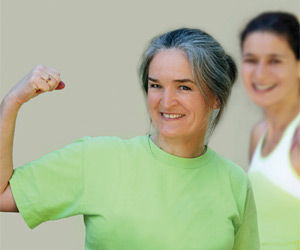
Think about your grandmother…now imagine her running sprints and pumping out pull-ups.
Not quite what you pictured when you suggested she get a personal trainer?
Despite the fitness trend of “training your grandmother like you train your athletes,” the reality is that some workout progressions just don’t translate. Yes, the needs of older adults are the same as athletes in terms of basic movement patterns like bending-and-lifting, squatting and twisting, but just about everything else is different.
One-size-fits-all workouts could mean terrible mistakes—especially when you’re dealing with a demographic that is already at a higher risk of osteoporosis and falling due to loss of bone mass and balance.
“Cardio, movement and strength training, flexibility, balance and core work—the need for all that still applies for older adults, especially for the preservation of muscle mass and bone density as we age,” explains ACE Exercise Physiologist Jessica Matthews. “But trainers need to keep in mind that musculoskeletal injuries are the number-one reason people over the age of 65 seek medical attention. Developing sound exercise programs that focus on stability and mobility and improving quality of movement is essential, especially with this demographic.”
Consider the following five primary movement patterns and corresponding exercises, which you can incorporate into workout programs for older adults to meet their unique needs and better prepare them for activities of everyday life:
- Squatting/Bend-and-lift. From sitting down in their favorite chair to bending down to pick up one of their grandkids, the squat is a movement your clients perform regularly in their everyday lives. Teaching clients proper squatting technique, starting with mastering the hip hinge, will help them relearn this critical movement pattern effectively.
- Lunging/Single-leg Movements. Climbing up a flight of stairs or bending down to tie one’s shoes may seem like nothing more than simple everyday occurrences to your clients. However, breaking down the components of how to effectively perform the forward lunge, starting with first learning single leg-stands on the ground, will not only help ensure they are moving safely, but it will also enable them to perform some daily tasks with greater ease.
- Pushing and Pulling. Movements such as swinging open a door or propping oneself up from a lying position in bed to a seated position involve pushing and pulling, both of which include the need for thoracic and glenohumeral mobility and scapulothoracic stability. Helping your clients to first understand good scapular position through movements such as shoulder packing and then focusing on thoracic extension and shoulder stability and mobility through I, Y, T and W formations will help to effectively prepare your clients for these movements.
- Rotational. Whether leisurely hitting golf balls at the driving range or simply turning to grab something that’s sitting on the kitchen counter, rotational movements are among the most complex movement patterns. There is a great need for thoracic mobility, as well as lumbar stability, because clients may be more susceptible to injuries in the hips and shoulders during rotational movements. Incorporating foundational exercises such as bird-dog is an excellent way to train the body to stabilize the lumbar spine during movements of the upper and lower extremities, while exercises like prisoner rotations help promote thoracic spine mobility in the transverse plane.
Learn more about how to apply the current trend of “training your grandmother like you train your athletes” in our upcoming webinar by ACE Fit Expert Jonathan Ross on June 6, 2012. You’ll learn proper starting points and progressions, and why adapting training programs is about more than just “scaling intensity.” To register, visit ACEfitness.org/livewebinars.